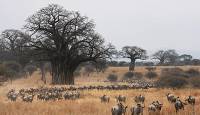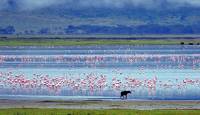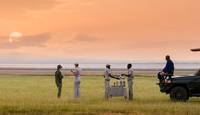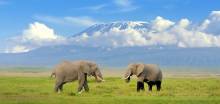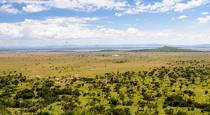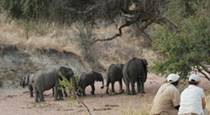There are two main cities in Tanzania. The first and biggest is Dar es Salaam, which is the commercial capital. The second largest is Dodoma and serves as the administrative capital of the country.
Ngorongoro Conservation Area
Declared a World Heritage Site, the Ngorongoro crater is a remnant of an ancient volcanic peak which once dominated the surrounding landscape and formed its lava plains in the vicinity. Today it is completely inactive and the plains are covered by soil and vegetation and is the preserve of 25 000 larger mammals, including the Big Five. The spectacular variety of wildlife and the vast number of animals in this area can hold you spellbound for days and warrants inclusion in a Tanzania travel experience. Transformed by the passage of time into a natural Eden known as the Ngorongoro Conservation Area of about 8 000 square kilometres, its serene beauty includes Lake Eyasi in the south and the world famous Olduvai gorge ,where Dr Louis Leakey discovered the remains of Australopithecus boisei, and established Africa’s claim to be the ‘cradle of humankind’. There is a museum of palaeontology, as well as guided tours, which will fascinate African safari participants for hours.
To the north are the Gol Mountains and just beyond them lies Lake Natron, one of the strangest environments in the world. Heated not only by the brilliant sunshine but also by volcanic vents from the foot of mount Ol Doinyo Lengai, the lake has natural hot water in which a huge variety of creatures flourished. The Ngorongoro area is the homeland of the Masai people who share a symbiotic relationship with the herds of cattle they take care of. With their tall stature, striking traditional dress and a history of one of the most demanding rites of passage ever documented - young men were expected to kill a lion single-handed, armed only with a spear, they are surely one of the most distinctive of the surviving tribal cultures on earth. Read up on this culture before you depart on your Tanzania safari and prepare to be amazed.
Lake Manyara National Park
The park is found 125 kilometres west of Arusha town, southeast of the Ngorongoro Crater, below the escarpment of the Great Rift Valley in Northern Tanzania. The park is 330 square kilometres, of which 230 kilometres is covered by Lake Manyara. The most eminent wildlife at Manyara are the tree climbing lions, elephant, zebra, hartebeest, impala, hippos and millions of birds - countless pelicans and flamingos, images of which are often depicted on Tanzania travel literature.
Serengeti
The park lies in a high plateau between the Ngorongoro highlands and the Kenya / Tanzania border, and extends almost to Lake Victoria, covering an area of 14 763square kilometres. It comprises of a huge preserved ecosystem of Africa and one of the most breathtaking events in the animal kingdom - the migration of thousands of wildebeest and zebras that takes place every year. This spectacle sees more than one million wildebeest, 200 000 zebras, and 300 000 gazelles trek to new grazing lands. The Serengeti National Park contains an estimated three million large animals and over 400 bird species. Other animals are lion, eland, hartebeest, giraffe, cheetah and leopard. The Serengeti National Park is an extremely popular Tanzania travel destination.
Tarangire National Park
The park lies south of an unrivalled landscape of open plains of the Maasai land, southeast of Manyara in Northern Tanzania and covers 2 600 square kilometres. It is famous for its dense wildlife population. Tarangire is most impressive between June and November, when herds of animals crowd around the permanent waters of the Tarangire River. It is also well known for its zebra, elephant, hartebeest, buffaloes, waterbuck, gazelles, Oryx and prolific bird life which lures Tanzania safari participants from around the globe.
Selous Game Reserve
This is the largest protected wildlife area in Africa, situated in the Southern part of Tanzania covering an area of 55 000 square kilometres. It possesses a diverse landscape of hot volcanic springs, sporadic lakes and channels from the great Ruaha and Rufiji rivers. Selous is famous for its elephants and hippos. Other animals are buffalo, eland, bushbuck, waterbuck, zebra, giraffe, lion, wildebeest, leopard and spotted hyena. There are over 350 species of bird and reptiles such as crocodiles and various snakes.
Ruaha National Park
This is a pristine and untouched park covering an area of 12 950 square kilometres. This is the second largest park in Tanzania and is situated 140 kilometres from Iringa town in Tanzania. The Great Ruaha River is an amazing sight in the Park with goliath herons, hippo and crocodiles found there. There are about 1000 elephants, 30 000 buffalo, 20 000 zebras and many prides of lion and leopards, together with more than 400 bird species - all of which combine to create a spectacular backdrop for an African safari.
Arusha National Park
Arusha National Park offers a variety of environments from full forest to swamp and grassland areas, which are home to elephant, hippo, buffalo and giraffe as well as leopard, hyena, the black and white colobus monkey and 400 species of migratory and indigenous birdlife. Tarangire, near to the town of Arusha, is a well-populated wildlife area, which guarantees easier sightings of animals on game drives during Tanzania safaris. Lake Manyara is, like Lake Natron to the north, a soda lake where the combination of sun, volcanic activity and a high mineral content in the water has made for special adaptations by the wildlife of the area.
Mount Kilimanjaro
According to local legend, is the home of an angry god who guards against intruders. The summit of Kilimanjaro can be reached by a route that is a steep walk, rather than a mountaineer’s ascent, and takes about six days to achieve. Only the last part is arduous, as a result of the lack of oxygen at this altitude. The view from the peak is incomparable, but the entire climb presents an ever-changing series of natural environments from tropical rainforests to an eerie world of ice and snow - which contains the only permanent glaciers that can be viewed on an African safari.
The country is situated just south of the Equator bordering the Indian Ocean and is 930,704 square kilometres in area. Of this, inland waters cover 53,000 square kilometres and 247,537 square kilometres is devoted to the protection of wildlife. Most of the land area of the country falls within the central plateau region, although the most distinctive feature is the Great Rift Valley with its associated series of lakes from Nyasa in the south, to Tanganyika in the west and Victoria in the north - all of which are popular Tanzania travel attractions. Volcanic activity is common throughout the Rift Valley area. The coastline comprises long tropical beaches and the major offshore islands of Zanzibar, Mafia and Pemba. The population presently occupying Tanzania is about 30,3 million. Population density is measured at approximately 3,2 people per square kilometre.
If you would like to include cultural and historical aspects of Tanzania in your African safari, there is no better place to start than the capital, Dar es Salaam, which means ‘haven of peace’ in Arabic. A whole tapestry of history is played out in the architecture and streets of this city with fantastic mosques, traditional and busy Indian bazaars. For an insight into present lifestyles, which still follow a tradition as old as Africa itself, visit the Kariakoo Market where every variety of vegetable, fish and livestock is on sale, along with a fascinating range of traditional medicines and spices. An even better window is the Nyumba ya Sanaa, a local handicraft centre where you can buy anything in the line of painting, pottery, carvings or batik fabric designs to take home as souvenirs of your Tanzania travel experience.
Just north of Dar es Salaam is the former capital of the country and popular Tanzania travel destination, Bagamayo. The name is said to be derived from the cry of slaves brought here for sale and transport, and means ‘Here I lay down my heart’. The sombre history of this once great city is evidenced by the remnants of the slave trade - shackle rings, cell-like stone pits in which the slaves were kept and the rare examples of freedom certificates.
On a more optimistic note, this was also the starting point for many of history’s most famous explorers. David Livingstone is especially well remembered here in the museum collection at the Catholic Mission, but Burton and Speke also passed through this city and Stanley’s own house still stands here as a monument to those great adventurers, which make for interesting Tanzania safari attractions.
As one of the best-established economies in Africa, Tanzania has a well developed infrastructure and many investment opportunities. The main activity in the country is agriculture, but the industrial base is also developing towards manufacturing. Mining is also a very important sector, as well as tourism, which is one of the strongest growing sectors and supports a variety of African safaris.
Whilst African Travel Gateway does not arrange visas, the following information has been provided to assist you in finding out the visa requirements for the passport that you are holding. While every effort is made to keep this information updated, it is subject to change.
Visas are required by nationals from most countries. Travelers are advised to obtain visas in advance but they can be issued on arrival for the relevant fees for a visa.
The island of Zanzibar is part of the United Republic of Tanzania, so there is no need to obtain a second visa if your itinerary will include both Tanzania & Zanzibar or Pemba Island
Below are the issuing authorities in the Southern Africa region. One should first however, check if there is a Tanzanian Consulate in your country of residence. This will make the process of applying for a visa a lot simpler:
High Commission of Tanzania
822 George Avenue, Arcadia, 0007
P.O Box 56572, Arcadia, 0007
Tel: (+27 12) 342 4393 / 71
Fax: (+2712) 430 4383
Visitors should have an International Certificate of Vaccination against Yellow Fever. Anti-malaria tablets are recommended and are to be taken a few days prior to your Tanzania safari, during your stay, and for a short period after returning. Precautions against other tropical diseases should be taken - we suggest you consult your doctor or local travel clinic.
There some reputable clinics in Dar es Salaam, but you are advised to take out comprehensive travel insurance to cover you in the event that you need it.
The classic Tanzania safari from July to September, as this is when the Mara provides one of nature’s most dramatic spectacles, the annual migration of over a million wildebeest and zebra, teeming from the south to cross the Mara River into the Masai Mara National Reserve. The stunning Savannah stretches on forever. In the vast landscape you can see Cheetah the fastest animal in the world, chasing Antelope and Gazelle. In the Mara River hippos bathe, and on the banks, crocodiles sun themselves. This is truly one of the world’s very special places.
As East Africa’s plains fade yellow after the summer’s rains, an ancient signal is sent to millions of beast as one, the horizon blurring with the bodies of 1.4 million wildebeest and 200 000 zebra, eland and gazelle, relentlessly tracked by Africa’s great predators. This is the migration - one of the most awe-inspiring sights on earth.
The migration has its origin on Tanzania’s southern Serengeti plains, where great herds of wildebeest, zebra and Thomson’s gazelle gather to graze on the rain-ripened grass in January. But by the end of May the depleted plains are unable to sustain them - and an ancient impulse commands them to move. Like iron filings being drawn by a magnet, the great herds sweep north towards the Masai-Mara plains of Kenya.
By July the herds have amassed along the swollen Mara River - their final barrier from the short, sweet grasses ahead. With wild eyes, they plunge in to face the crocodiles which await them. Many who struggle through the deadly flotilla are drowned, or else weakened, falling prey to ambushing lions. This is the dramatic life-and-death struggle that travellers have come to see. Between June and October the herds total 1.4 million beasts in the Masai Mara (Kenya). Here the green grass of the Mara-plains nourishes them until the arrival of the November rains, calling them back south again. Back on the rain-sweetened Serengeti grasslands, the pregnant females give birth in spontaneous profusion. The circle of life is completed.
The following banks are represented in the main centres around Tanzania: Barclays Bank, Standard Chartered, Exim Bank and a number of local banks.
There is no restriction on the importation of foreign currency, however, the import or the export of Tanzanian shillings is prohibited. Visitors can change their foreign currency at any of the Bureaux de Change which give a better rate than the banks, and at certain hotels. This money can be used for personal expenses like shopping, meals and drinks in town restaurants or safari lodges. Note that USD notes printed PRIOR to 1990 are often not accepted. We recommend a combination of cash and travellers cheques, preferably in small denomination notes - otherwise you will end up carrying large wads of Shillings around!
English and Kiswahili are the official languages, although there are more than 120 tribal languages spoken in remote areas which fall into at least three major language groups: Bantu, Nilo-Hamitic and Khoisan.
Local people are generally friendly and particularly welcoming to any visitor who can command a couple of words in Swahili. For the more adventurous traveller, there are many rituals, ceremonies and festivals of traditional music, which are well worth experiencing. There are large numbers of Muslims, Christians and Hindus as well as a strong following of traditional African beliefs in country areas.
The sheer variety of African and Muslim cuisine is too large to catalogue and changes from one region to the next. The parts not to be missed, though, are the spicy and sweet specialities in Dar es Salaam and Zanzibar. The local population eat a lot of maize meal as well as rice. There is also host of local beers specific to the various tribes, but the most common is “Mbege” from the Chagga Tribe.
Tanzania is a friendly country, and there are many shop outlets geared to tourists, which sell a wide range of curios, clothing, wood carvings and Masaai handmade jewellery that you may take home as keepsakes of your African safari. However, as with any city or town, please be VERY careful when shopping, do not wander around at night in towns (use taxis), and do not leave valuables in hotel rooms etc. Lock up in safes where available.
The electricity is mainly generated by hydropower in Tanzania. The main supply is 240V AC, 50Hz. Wall plugs can be either round or square pin types.
Tap water is not reliable in Tanzania and should be treated. To be safe rather drink bottled mineral water, which is readily available.
As indicated under “shopping”, Tanzania is a friendly country. However, as with any city or town, please be VERY careful when shopping, do not wander around at night in towns (use taxis), and do not leave valuables in Tanzania hotel rooms etc. Lock up in safes where available.
